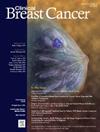A Deep-Learning Solution Identifies HER2 Negative Cases and Provides ER and PR Results From H&E-Stained Breast Cancer Specimens: A Blind Validation Study
IF 2.5
3区 医学
Q2 ONCOLOGY
引用次数: 0
Abstract
Background
PANProfiler Breast is a UKCA-marked, deep-learning image analysis tool. It provides oestrogen and progesterone receptor (ER/PR) status and identifies human epidermal growth factor receptor-2 (HER2) negativity from whole slide images (WSIs) of haematoxylin and eosin (H&E)-stained breast cancer (BC) tissue. This study blindly validated PANProfiler’s prediction of ER/PR status and identification of HER2 negative status.
Materials and Methods
Three cohorts of WSIs of H&E-stained BC specimens were used for calibration (200 cases, 344 WSIs) and blind validation (200 cases, 348 WSIs). For the blind validation, PANProfiler analysed WSIs to provide results for ER, PR ("Positive," “Negative,” or “Indeterminate”) and HER2 ("Negative” or “Indeterminate”). These were compared to the corresponding pathology reports. To discern PANProfiler’s performance, concordance and other metrics were calculated, including test replacement rate (TRR) (cases PANProfiler produced a definitive result for) and complete test replacement rate (CTTR) (cases with definitive results for all markers).
Results
Following blind validation, concordance for ER and PR status across the cohorts was 90%-93% and 86%-91%, respectively. The TRR for ER was 70%-84% and 55%-84% for PR. For HER2 negative cases, concordance across cohorts was 91%-100%, with a TRR ranging from 22% to 27%. CTTRs for the cohorts were between 18% and 20%.
Conclusion
PANProfiler Breast showed high concordance for ER and PR status and identified HER2 negativity from WSIs of H&E-stained BCs. For HER2 negativity, whilst the TRR was lower than that of ER and PR, the high level of concordance indicated its reliability in identifying negative cases.
一个深度学习解决方案识别HER2阴性病例,并提供her和PR结果从h&e染色乳腺癌标本:一项盲验证研究。
背景:PANProfiler Breast是一个ukca标记的深度学习图像分析工具。它提供雌激素和孕激素受体(ER/PR)状态,并从血红素和伊红(H&E)染色的乳腺癌(BC)组织的全切片图像(WSIs)中识别人表皮生长因子受体-2 (HER2)阴性。本研究盲目验证了PANProfiler对ER/PR状态的预测和HER2阴性状态的识别。材料与方法:采用3组h&e染色BC标本wsi进行校准(200例,344例)和盲法验证(200例,348例)。对于盲法验证,PANProfiler分析wsi以提供ER, PR(“阳性”,“阴性”或“不确定”)和HER2(“阴性”或“不确定”)的结果。将这些与相应的病理报告进行比较。为了辨别PANProfiler的性能,一致性和其他度量被计算,包括测试替换率(TRR) (PANProfiler产生明确结果的案例)和完全测试替换率(CTTR)(所有标记具有明确结果的案例)。结果:经过盲法验证,整个队列中ER和PR状态的一致性分别为90%-93%和86%-91%。ER的TRR为70%-84%,PR为55%-84%。对于HER2阴性病例,各队列的一致性为91%-100%,TRR范围为22% - 27%。这些队列的ctr在18%到20%之间。结论:PANProfiler Breast显示her和PR状态高度一致,h&e染色的bc的wsi检测出HER2阴性。对于HER2阴性,虽然TRR低于ER和PR,但高一致性表明其在识别阴性病例方面的可靠性。
本文章由计算机程序翻译,如有差异,请以英文原文为准。
求助全文
约1分钟内获得全文
求助全文
来源期刊

Clinical breast cancer
医学-肿瘤学
CiteScore
5.40
自引率
3.20%
发文量
174
审稿时长
48 days
期刊介绍:
Clinical Breast Cancer is a peer-reviewed bimonthly journal that publishes original articles describing various aspects of clinical and translational research of breast cancer. Clinical Breast Cancer is devoted to articles on detection, diagnosis, prevention, and treatment of breast cancer. The main emphasis is on recent scientific developments in all areas related to breast cancer. Specific areas of interest include clinical research reports from various therapeutic modalities, cancer genetics, drug sensitivity and resistance, novel imaging, tumor genomics, biomarkers, and chemoprevention strategies.
 求助内容:
求助内容: 应助结果提醒方式:
应助结果提醒方式:


